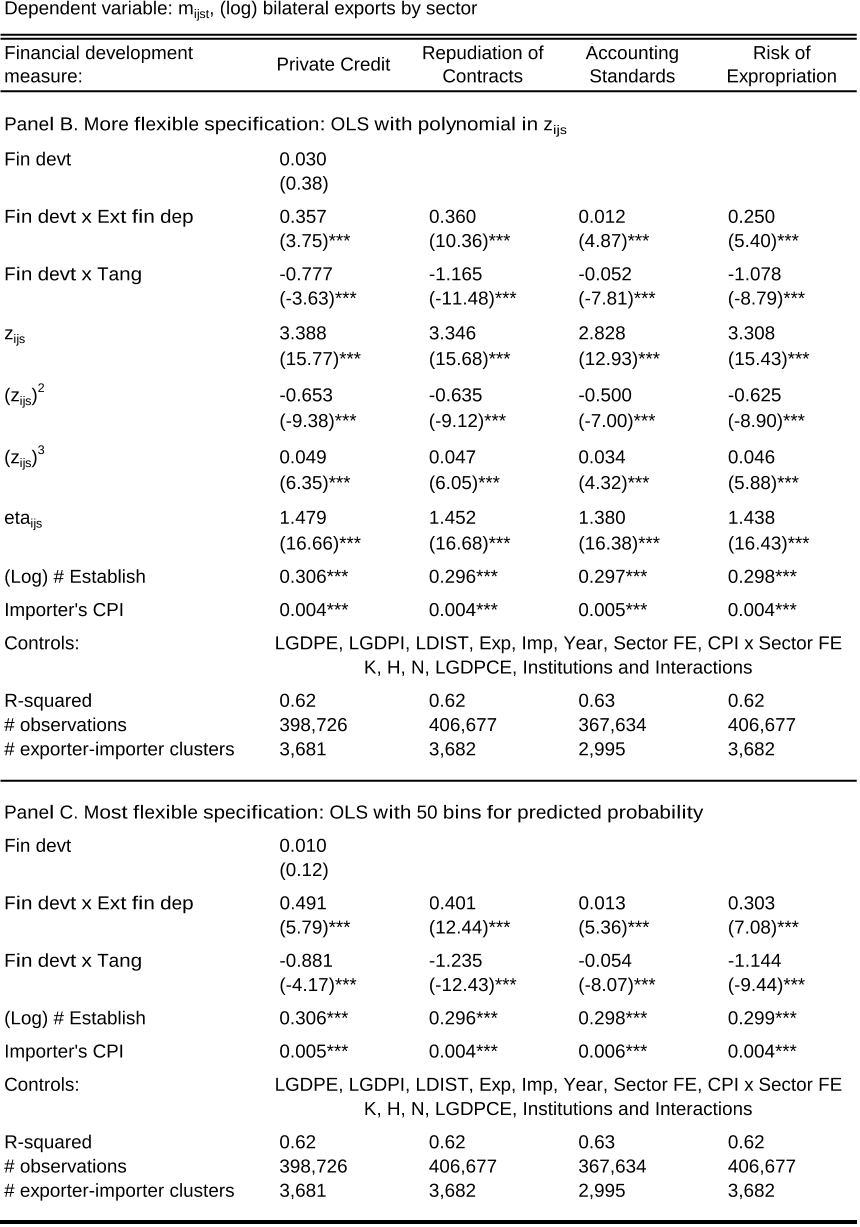Credit Constraints, Heterogeneous Firms and International Trade
Reads0
Chats0
TLDR
This article examined the detrimental consequences of financial market imperfections for international trade and developed a heterogeneous-firm model with countries at different levels of financial development and sectors of varying financial vulnerability.Abstract:
This paper examines the detrimental consequences of financial market imperfections for international trade. I develop a heterogeneous-firm model with countries at different levels of financial development and sectors of varying financial vulnerability. Applying this model to aggregate trade data, I study the mechanisms through which credit constraints operate. First, financial development increases countries' exports above and beyond its impact on overall production. Firm selection into exporting accounts for a third of the trade-specific effect, while two thirds are due to reductions in firm-level exports. Second, financially advanced economies export a wider range of products and their exports experience less product turnover. Finally, while all countries service large destinations, exporters with superior financial institutions have more trading partners and also enter smaller markets. All of these effects are magnified in financially vulnerable sectors. These results have important policy implications for less developed economies that rely on exports for economic growth but suffer from poor financial contractibility.read more
Figures

Table 10. Economic Significance: Predicted vs. Actual Trade Growth 
Table 9. Economic Significance: Comparative Statics 
Table 5. Financial Development and Firm-Level Exports 
Figure 3. The Productivity Cut-off for Exporting 
Table 5. Financial Development and Firm-Level Exports 
Table 1. Export Patterns in the Data
Citations
More filters
Posted Content
Estimating Trade Flows: Trading Partners and Trading Volumes
TL;DR: In this paper, the impact of trade frictions on trade flows can be decomposed into the intensive and extensive margins, where the former refers to the trade volume per exporter and the latter referred to the number of exporters.
Journal ArticleDOI
Finance and Development: A Tale of Two Sectors †
TL;DR: This article developed a model co-determining aggregate total factor productivity (TFP), sectoral TFP, and scales across industrial sectors and found that financial frictions disproportionately affect TFP in tradable sectors where production requires larger costs.
Posted Content
Exports and Financial Shocks
Mary Amiti,David E. Weinstein +1 more
TL;DR: In this article, a causal link between the health of banks providing trade finance and growth in a firm's exports relative to its domestic sales is established, suggesting that trade finance accounts for about one-third of the decline in Japanese exports in the financial crises of the 1990s.
Journal ArticleDOI
Off the Cliff and Back? Credit Conditions and International Trade During the Global Financial Crisis
TL;DR: This article studied the collapse of international trade flows during the global financial crisis using detailed data on monthly US imports and showed that credit conditions were an important channel through which the crisis affected trade volumes, by exploiting the variation in the cost of capital across countries and over time.
Journal ArticleDOI
The Empirics of Firm Heterogeneity and International Trade
Andrew B. Bernard,Andrew B. Bernard,Andrew B. Bernard,J. Bradford Jensen,J. Bradford Jensen,Stephen J. Redding,Peter K. Schott,Peter K. Schott,Peter K. Schott +8 more
TL;DR: A review of empirical evidence on firm heterogeneity in international trade can be found in this article, where a first wave of empirical findings from micro data on plants and firms proposed challenges for existing models of international trade and inspired the development of new theories emphasizing firm heterogeneity.
References
More filters
Posted Content
Volatility and Growth: Credit Constraints and Productivity-Enhancing Investment
TL;DR: In this article, the authors examine how credit constraints affect the cyclical behavior of productivity-enhancing investment and thereby volatility and growth, and find that tight credit leads to both higher aggregate volatility and lower mean growth for a given total investment rate.
Journal ArticleDOI
Finance and trade: A cross-country empirical analysis on the impact of financial development and asset tangibility on international trade
TL;DR: This paper investigated the interplay between financial development, asset tangibility, and international trade and found that economies with higher levels of financial development have higher export shares and trade balance in industries with more intangible assets.
Journal ArticleDOI
Comparative advantage, demand for external finance, and financial development
Quy-Toan Do,Andrei A. Levchenko +1 more
TL;DR: This article showed that financial development is an equilibrium outcome that depends strongly on a country's trade pattern and that financial systems are more developed in countries with large financially intensive sectors, while financial development in countries that primarily export goods which do not rely on external finance is lower.
Journal ArticleDOI
Credit market imperfections and patterns of international trade and capital flows
TL;DR: In this article, two simple models to illustrate how corporate governance, contractual enforcement, and the balance sheet condition of the business sector etc., can affect the patterns of international trade and capital flows in the presence of credit market imperfections.
Journal ArticleDOI
Do Sunk Costs of Exporting Matter for Net Export Dynamics
George Alessandria,Horag Choi +1 more
TL;DR: In this article, the authors derive the discrete entry and exit decisions yielding exporter dynamics in an open economy business cycle model, and show that export decisions have negligible aggregate effects in a general equilibrium environment.